TCP IP Architecture Design - Sameer Seth#
[TCP IP Architecture Design - Sameer Seth]
OVERVIEW OF TCP / IP STACK#
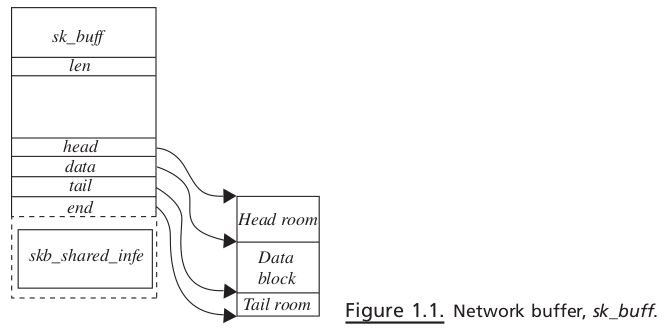
Moving Down the Stack#
When an application wants to write data over the TCP socket,
the kernel reaches the socket through VFS (see Fig. 1.2 ).
inodefor the file of the type socket contains a socket object, which is the starting point for the networking stack (see Section 3.2 for more details).The
socketobject has a pointer to a set of operations specific to the socket type pointed to by fieldops.Object
proto_opshas a pointer to socket-specific operations. In our case, the socket is of type INET, sosendsystem call ends up callinginet_sendmsg()inside kernel via VFS.The next step is to call a protocol-specific send routine because there may be different protocols registered under INET socket (see Section 3.1 ).
In our case, transport later is TCP, so
inet_sendmsg()calls a protocol - specifi c send operation. The protocol-specific socket is represented by a sock object pointed to by theskfield of thesocketobject. A protocol - specific set of operation is maintained by aprotoobject pointed to byprotfi eld ofsockobject.inet_sendmsg()calls a protocol - specific send routine, which istcp_sendmsg().In
tcp_sendmsg(), user data are given to aTCP segmentation unit. The segmen- tation unit breaks big chunks of user data into small blocks and copies each small block tosk_buff. Thesesk_buffsare copied to the socket’ s send buffer, and then the TCP state machine is consulted to transmit data from socket send buffer. If the TCP state machine does not allow sending new data because of any reasons, we return. In such a case, data will be transmitted later by a TCP machine on some event which is discussed in Section 11.3.11 .If the TCP state machine is able to transmit
sk_buff, it sends a segment to the IP layer for further processing. In the case of TCP,sk -> tp -> af_specifi c -> queue_xmitis called, which points toip_queue_xmit().This routine builds an IP header and takes an IP datagram through the firewall policy.
If the policy allows, an IP layer checks if NAT/Masquerading needs to be applied to the outgoing packet.
If so, a packet is processed and is finally given to the device for fi nal transmission by a call to
dev_queue_xmit().Device refers to a network interface, which is represented by net_device object. At this point, the Linux stack implements QOS. Queuing disciplines are implemented at the device level.
Packet (
sk_buff) is queued to the device according to their priority levels and queuing discipline.Next is to dequeue the packet from the device queue, which is done just after queuing
sk_buff. The queued packet may be transmitted here, depending on the bandwidth for the packet ’ s priority.If so, the link layer header is prepended to the packet, and the device - specifi c hard transmit routine is called to transmit the frame.
If we are unable to transmit the frame, the packet is requeued on the device queue and Tx softIRQ is raised on the CPU adding device to the CPU ’ s transmit queue.
Later on when the TX interrupt is processed, frames are dequeued from the device queue and transmitted.

Moving Up the Stack#
We start with the reception of packets at the network interface. Interrupt is generated once the packet is completely DMAed on driver ’ s Rx ring buffer (for details see Section 18.5 )
In the
interrupt handler, we just remove the frame from the ring buffer and queue it on CPU’ s input queue(the CPU that is interrupted)Rx NET softIRQ is raised for the CPU by call to
netif_rx()(Old kernel)Later when Rx
softIRQis processed, packets are de - queued from CPU ’ s receive queue and processed one - by - oneThe packet is processed completely until its destination here, which means that the TCP data packet is processed until the TCP data segment is queued on the socket ’ s receive queue
netif_receive_skb()is called to process each packet in Rx softIRQ. The fi rst step is to determine the Internet protocol family to which a packet belongs. This is also known as packet protocol switching.We send the packet to the
raw socketin case anyraw socketis opened for the device.Once the protocol family is identified, which in our case is IP, we call the protocol handler routine. For IP, this is the
ip_rcv()routineip_rcv()tries to de-NAT or de-masquerade the packet at this point, if required.The routing decisions are made on the packet. If it needs to be delivered locally, the packet is passed through firewall policies configured for the locally acceptable IP packets
If everything is OK,
ip_local_deliver_finish()is called to find the next protocol layer for the packet.ip_local_deliver_finish()implements INET protocol switching code. Once we identify the INET protocol, its handler is called to further process the IP datagram. The IP datagram may belong to ICMP, UDP, and TCP.Since our discussion is limited to TCP, the protocol handler is
tcp_v4_rcv(). The very first job of the TCP handler is to find out socket for the TCP packet. This may bea new open requestfor thelistening socketor may be another packet for theestablished socket. So here, varioushash tablesare looked into.So here, various hash tables are looked into.If the packet belongs to the established socket, the TCP engine processes the TCP segment.
If the TCP segment contains in-sequence data, it is queued on the socket’s receive queue
If there are any data to be sent, they is sent along with the the
ACKfor the data arrived hereFinally, when application issues read over the TCP socket, the kernel processes the request by providing data from the socket’ s receive queue.
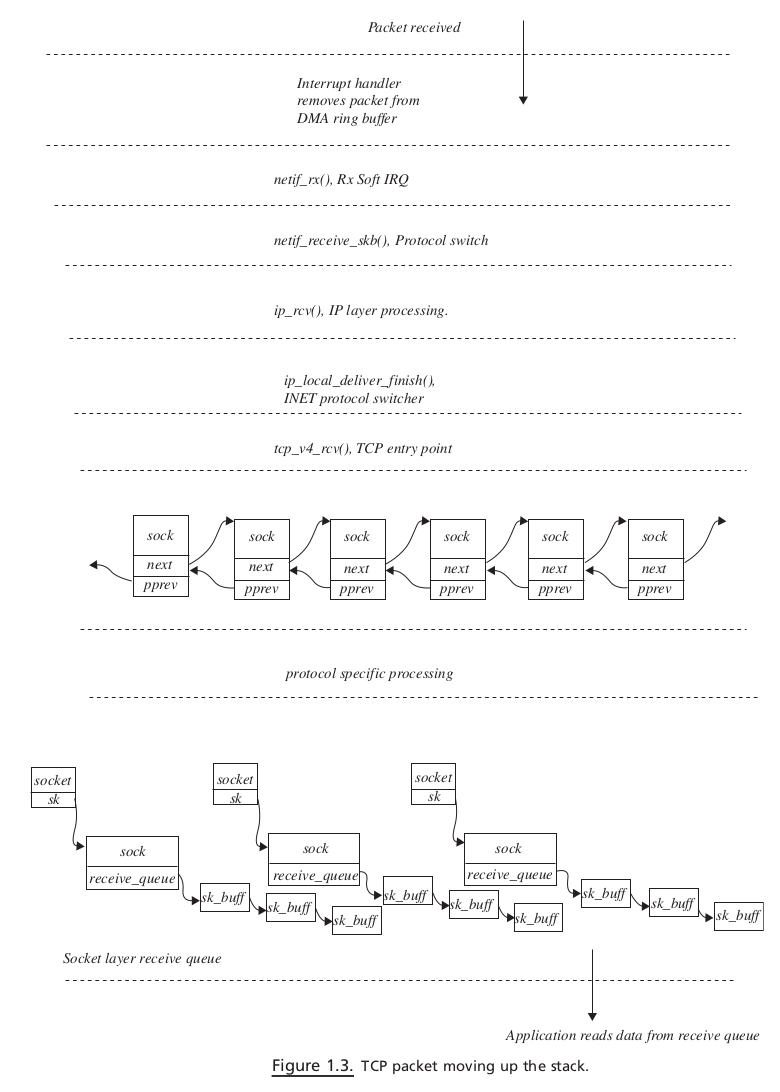
Linux stack maps to the OSI networking model#

SOURCE CODE ORGANIZATION FOR L INUX 2.4.20#
Kernel source tree#
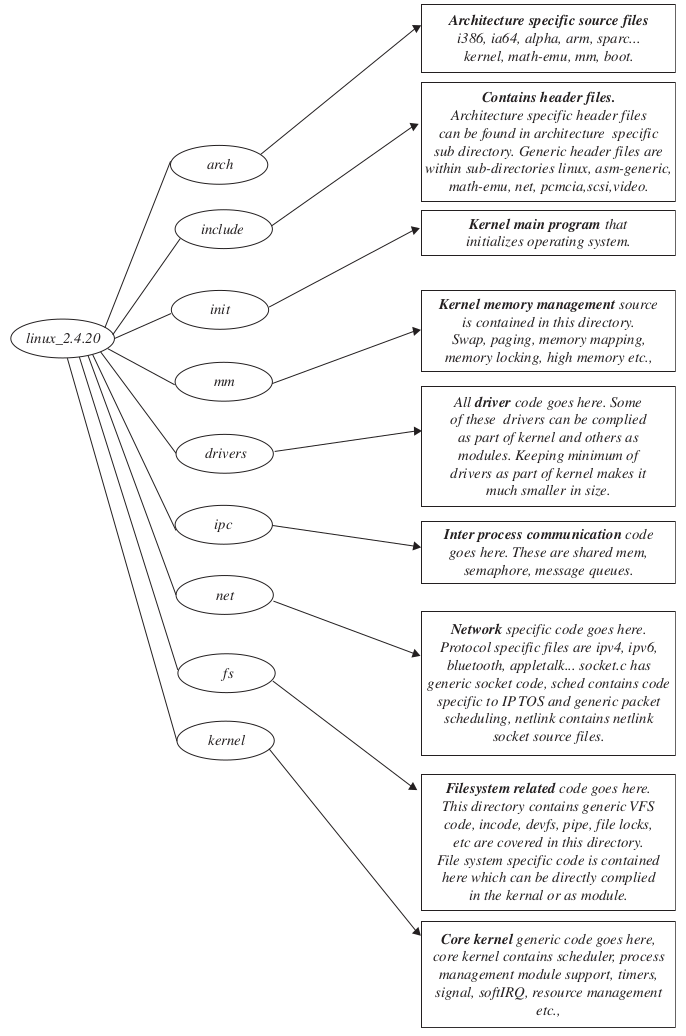
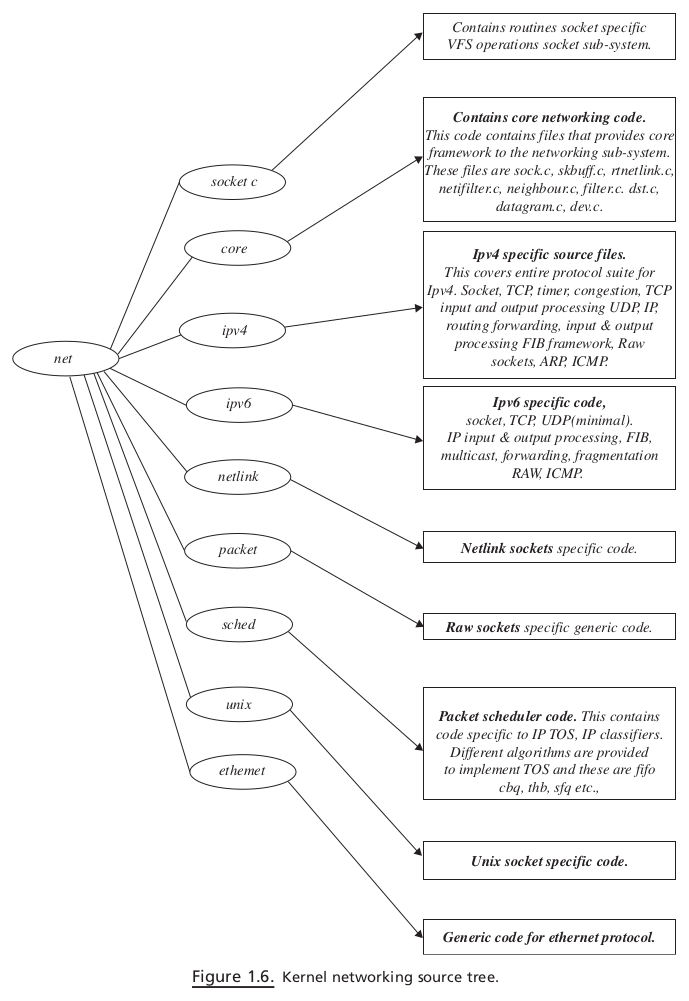
TCP / IP STACK AND KERNEL CONTROL PATHS#
Packet transmission#
In this section we will see how TCP data are being processed by the Linux kernel. In totality, we will see different kernel control paths and processor context that are involved in packet processing through the kernel. When the process writes data over the TCP socket, it issues write/send system calls (see Fig. 1.7 ). The system call takes the process from the user land to the kernel, and now the kernel executes on behalf of the process as shown by the solid gray line. Let ’ s determine the different points in the kernel where the kernel thread sending TCP data on behalf of the process preempts itself.
Figure 1.7 Packet transmission via different kernel control paths.:
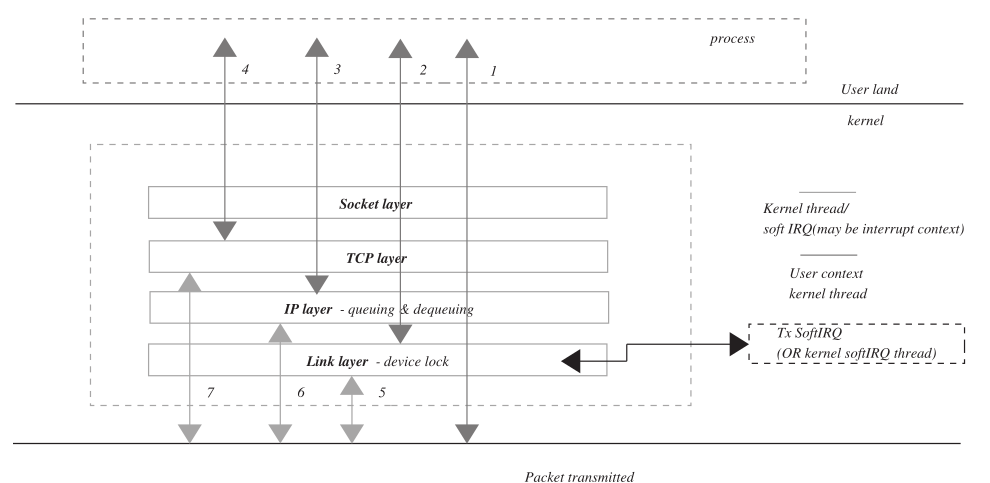
Kernel Control Path:
In this kernel control path, the kernel thread processes TCP data through the complete TCP/IP stack and returns only after transmittingdata from the physical interface.
This kernel control path processes data through TCP/IP stack but fails to transmit data because the device lock could not be obtained. In this case, the kernel thread returns after raising
Tx softIRQ.SoftIRQprocessing is deferred to some later point of time which will transmit data queued up on the device. See Section 17.1 for details onsoftIRQprocessing. 5. This kernel control path may execute ininterrupt contextorkernel context.Kernel contextmay come from softIRQ daemon, which runs askernel threadand has no user context. Kernel context may also come from kernel thread corresponding to user process which enables softIRQ on the CPU by call tospin_unlock_bh(). See Section 17.6 for more detail. This kernel control path processes all the data queued bycontrol path 2This kernel control path processes data through the TCP layer but is not able to take it further because the QOS policy is not allowing further transmission of data. It may happen that either someone else is processing the queue on which packet is queued or the quota for queue is over. In the later case, a timer is installed which will process the queue later. 6. This kernel control path executes as a high-priority
taskletthat is part ofsoftIRQ. This may also be executed ininterrupt contextorkernel contextas discussed above. This processes data queued bycontrol path 3.This kernel control path processes data through the TCP layer but cannot proceed any further and returns from here. The reason may be that the
TCP state machineorcongestion algorithmdoes not allow further transmission of data. These data will be processed later by the TCP state machine on generation of some TCP event. 7. This kernel control path executes assoftIRQwhen incoming TCP packet is being processed. When a packet is received, it is processed by Rx softIRQ. When a TCP packet is processed in softIRQ, it may generate an event causing transmission of pending data in the send queue. This kernel control path transmits data that are queued bycontrol path 4.
Packet reception#
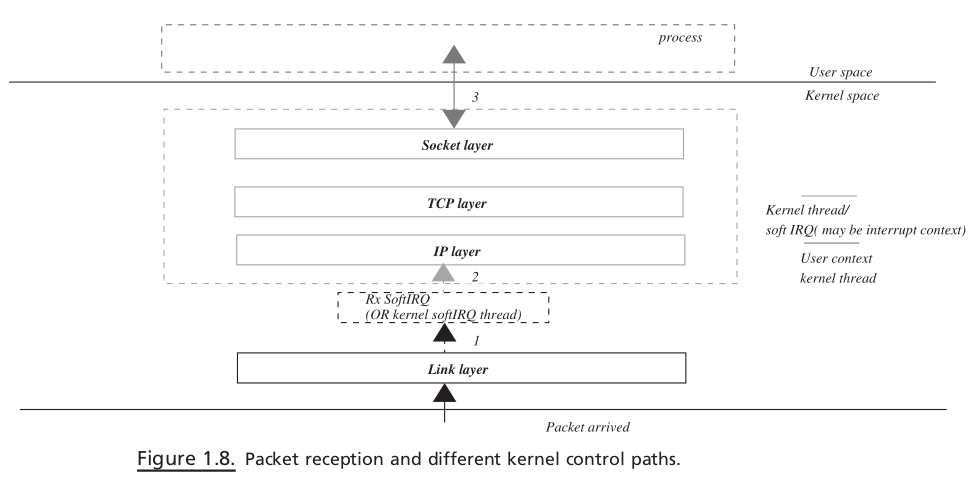 Figure 1.8. Packet reception and different kernel control paths.
Figure 1.8. Packet reception and different kernel control paths.
An interrupt handler plucks received a packet from the DMA ring buffer and queues it on the CPU - specifi c input queue and raises Rx softIRQ.
Rx softIRQ is processed at some later point of time in interrupt context or by softIRQ daemon. The TCP data packet is processed completely by Rx softIRQ until it is queued on the socket’s receive queue or is eaten up by the application.
The TCP ACK packet is processed by a TCP state machine, and softIRQ returns only after action is taken on the events generated by the incoming ACK.

APPLICATION INTERFACES FOR TCP / IP PROGRAMMING#
Socket Options#
SO_REUSEADDR#
Whenever any server application wants to bind to a port which is already in use by some other application on the same machine, this option may allow us to use the same port number under certain conditions. This option sets the reuse fi eld of the sock object. tcp_v4_get_port() is called inside the kernel through a bind path when application wants to bind to a specifi c port. We traverse through the bind hash list; and if we fi nd port already occupied and sk → reuse is set more than 1 (line 250, cs 1.9 ), we can directly use the port. Otherwise, if the value of sk → reuse is set to 1 (line 252, cs 1.9 ), it has to go through some additional checks before getting the port.
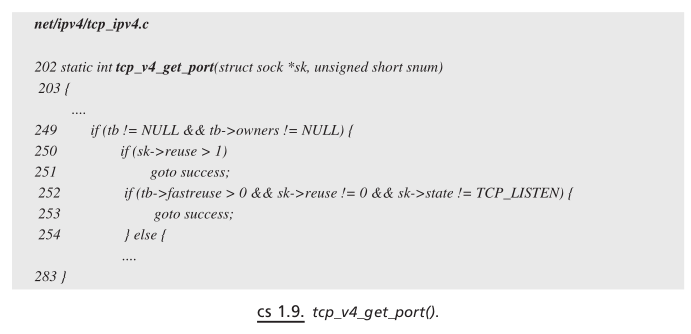
SO_KEEPALIVE#
This option enables a heartbeat mechanism for TCP connec- tion. An application like telnet may be active for months, where one end never knows about the other end when connections are ideal. It may happen that the one end has gone down, in which case the other end will never know. Half - connection will unnecessarily be open, thereby occupying resources. This option keeps sending messages to the other end once connection is idle for some time. In return, the sending end expects acknowledgment. If acknowledgments are not received, the connection is closed after a certain number of retries.
When the option is enabled, tcp_set_keepalive() is called to set the keepalive timer for TCP, and sk → keepopen is set to 1. tcp_set_keepalive() resets the keepalive timer in case it is not already set; this is done by calling tcp_reset_keepalive_timer() (see cs 1.10 , line 568)
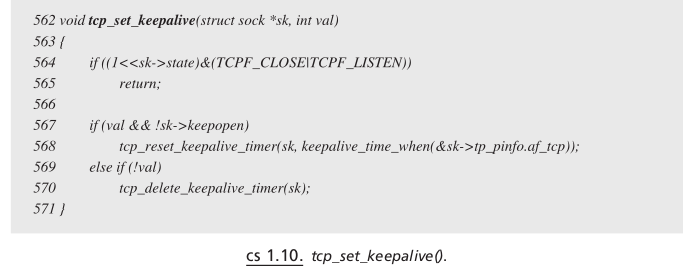
SO_LINGER#
SO_SNDBUF#
SO_RCVBUF#
SO_RCVTIMEO#
SO_SNDTIMEO#
TCP STATE#
Connect#
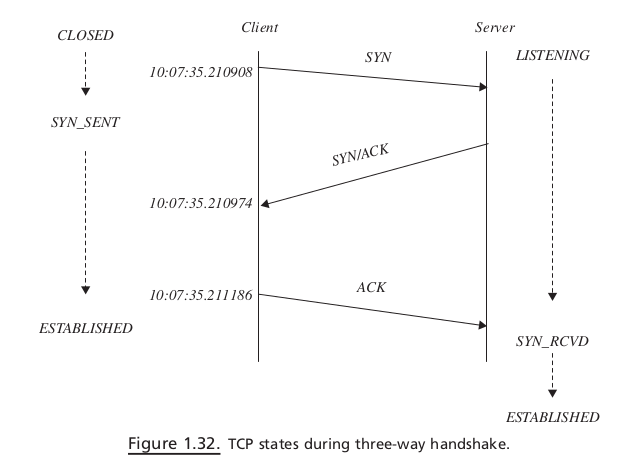
Close#
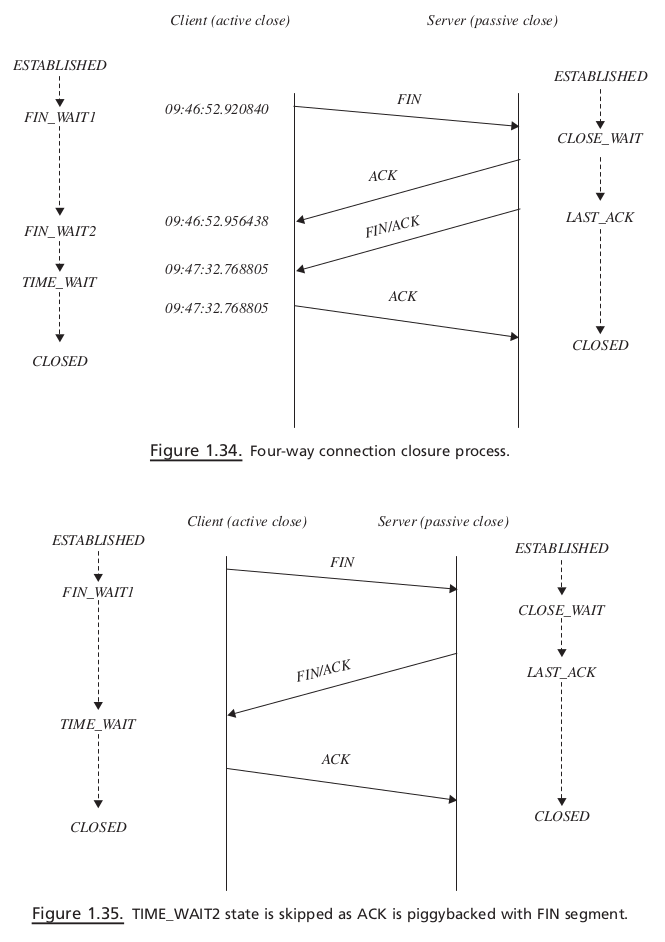
PROTOCOL FUNDAMENTALS#
Window Size#
This is a 16 - bit fi eld in the TCP header. TCP detects resource crunch of its peer with the help of this fi eld and acts accordingly. The fi eld indicates the receive buffer size available at any point of time. The receive buffer is consumed when data are received and is vacated as these data are processed and are consumed by the application. If the application is not able to consume the data from the receive buffer as fast as it is received, the receive buffer gets full and eventually the window size also reduces to 0. When the sender gets this information, it stops sending any more data until further notice of window size is advertised by the receiving end. Each TCP peer declares its window size at the time of synchronisation (connection initiation). We take this up in Section 2.6 (sliding window).
TCP DATA FLOW#
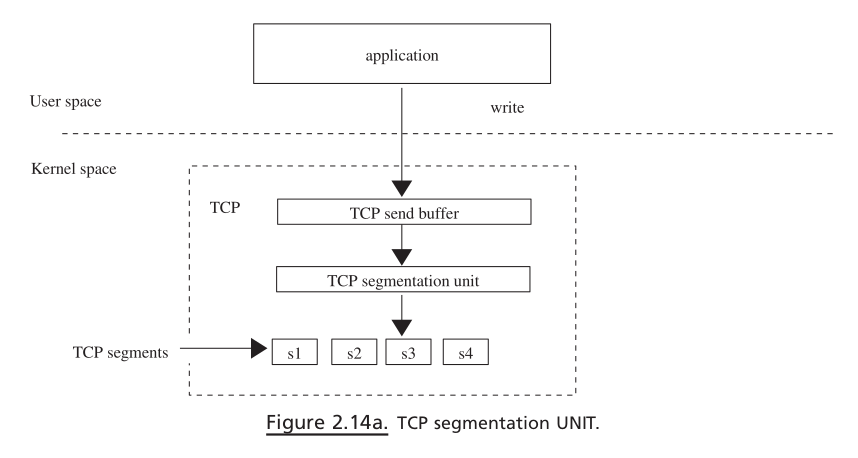
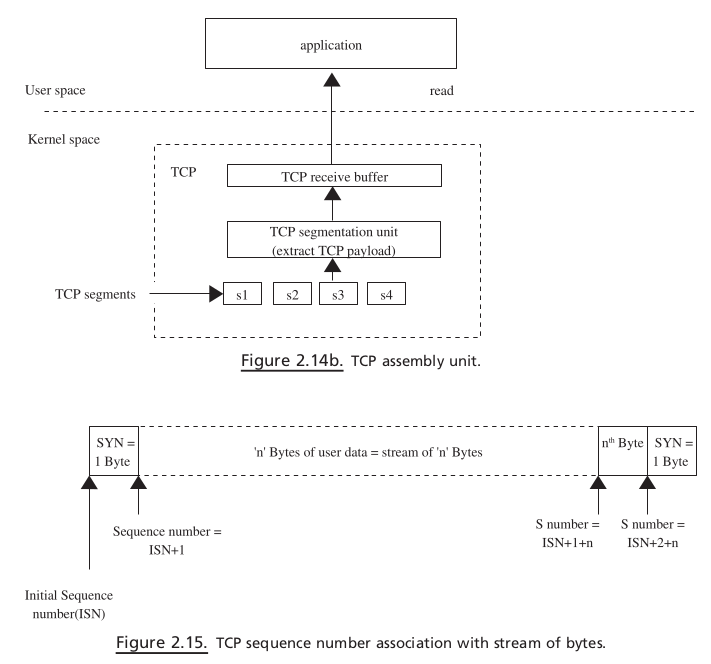
TCP TIMERS#
Retransmission Timer#
Whenever a TCP sends out data, it needs to make sure that the data have reached the receiver properly. For that it has to set a timer for the fi rst data segment that is transmitted. Once the ACK is received for the data, this timer is reset for the next data segment that was transmitted. The timer would expire after an interval that is decided by the round - trip time RTT for the route. RTT is the time taken by a data segment to be acknowledged, which is calculated using the TCP timestamp option.
If the timer expires, we can expect loss of all the segments in the last window trans- mitted and we start transmitting segments one - by - one from the last window. In this case we enter the loss state and slowdown rate of data transmission as we can sense network congestion.
Sometimes the RTT changes due to change in route or change in transmission medium; in this case, packets may get delayed and timeout may occur spuriously (check RFC 3522). RFC 2988 specifi es how effective RTO calcula- tion can be done.
Persistent Timer#
The TCP has its own fl ow control mechanism which is controlled by the buffer size at the receiving end. The sender TCP gets an idea of the amount of data to be transmitted from the window size advertised by the receiver. At the receiving end the data gets queued on the receive buffer, until it is consumed by the application. If the sender is sending data at a much faster rate than it can be read by the applica- tion, data will keep on queuing on the receiving TCP ’ s receive socket buffer. It may also happen that there is no space left out in the receiving TCP ’ s socket buffer. At this point in time, the receiving TCP advertises a zero window. When the sender gets zero window indication, it applies fl ow control on data and stops sending any more data until the receiver opens a window. In this situation, whenever the application reads data from the receiving TCP ’ s socket buffer, it generates space in the receive buffer for more data. In this process, the receiving TCP sends an ACK with a nonzero window. There is a probability that this ACK gets lost and the sender never gets the window open indication. In this case there would be a deadlock between the two TCP ends because the receiver thinks that it has already sent a window open segment and the receiver will send data whenever it has something, whereas the sender is waiting for a window open advertisement from the receiver, which it never gets.
To tackle this situation, the sender TCP sends out a zero - window probe that is exponentially backed off by way of the persistent timer. This timer sends out the next sequence number with no data. Linux sends out one sequence number smaller than what it has transmitted last.
Keepalive Timer#
TIME _ WAIT Timer#
KERNEL IMPLEMENTATION OF SOCKETS#
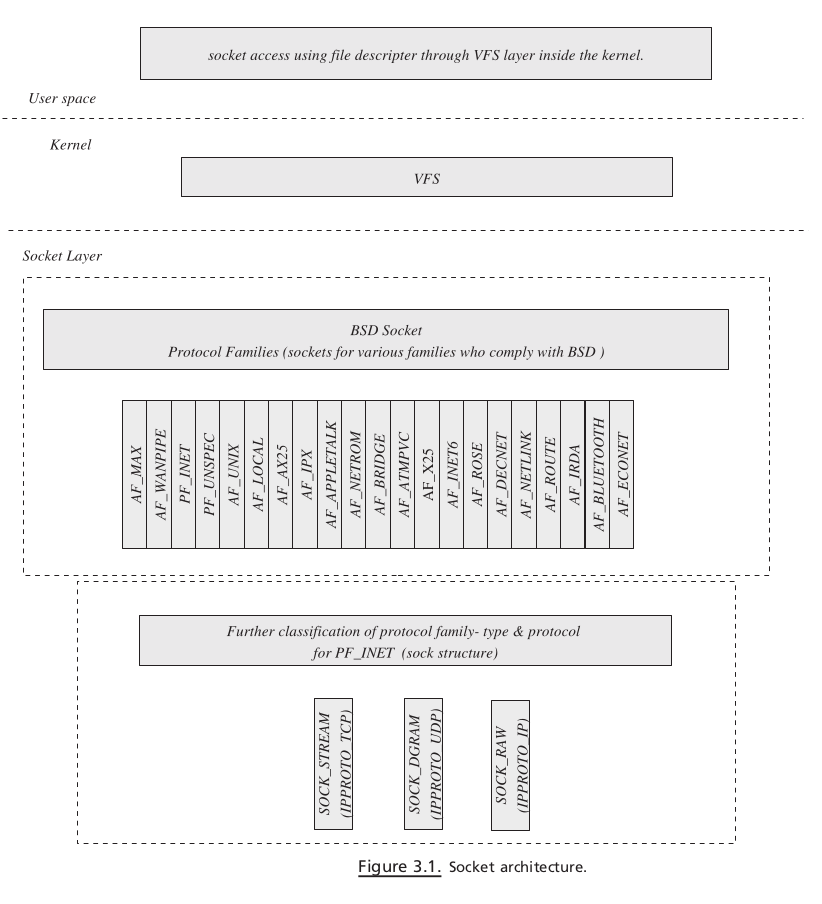
VFS AND SOCKET#
Let ’ s examine the kernel data structures and functions related to the socket layer.
sys_socket() is the function called in the kernel when user application makes a call
to socket() systemcall. The arguments to the socket() systemcall (to sys_socket() ) is
protocol, family, and type. These arguments passed to socket() systemcall is used
by the socket framework to decide the protocol stack to setup. sys_socket() does
nothing more than calling sock_create() to initialize the socket and sock structure
for the protocol family and links the socket with the VFS by calling sock_map_fd().
For association of VFS and socket, refer to Fig. 3.2 . Each process has a file table
that can be accessed from an fd field of object files_struct. fd is a double pointer of
type file . Each open file for the process has an associated file object linked with file descriptor. file objects are indexed into a file table with an associated file descriptor.
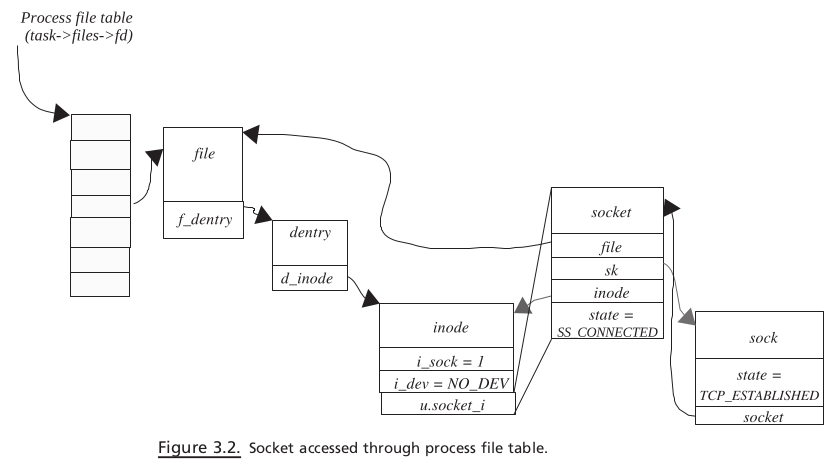
SOCKET ORGANIZATION IN THE KERNEL#
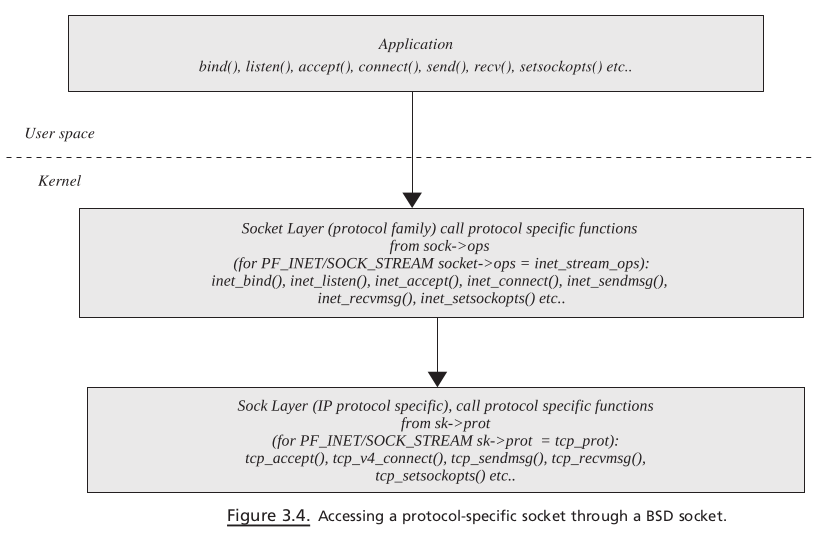
KERNEL IMPLEMENTATION OF TCP CONNECTION SETUP#
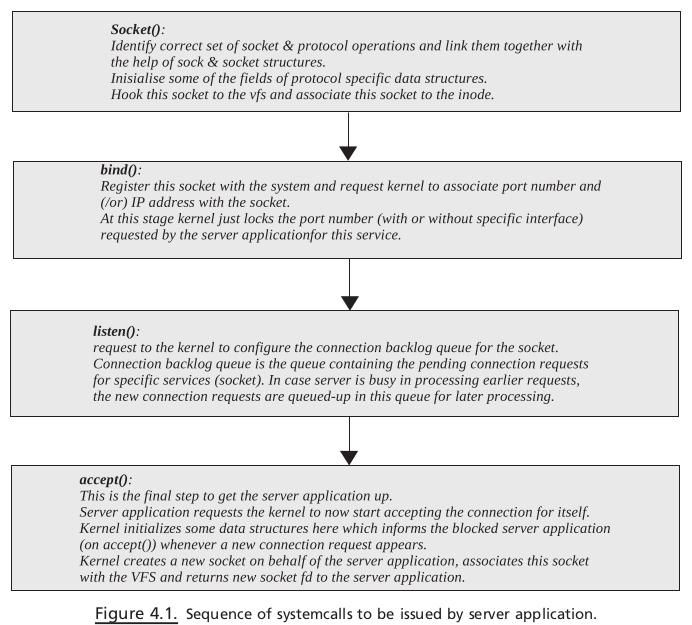
BIND#
Hash Buckets for tcp Bind#
tcp_ehash = tcp_hashinfo.tcp_ehash (Fig. 4.4 )
__tcp_bhash = tcp_hashinfo.__tcp_bhash (Fig. 4.5 )
tcp_listening_hash = tcp_hashinfo.__tcp_listening_hash (Fig. 4.6 )
tcp_ehash#
Figure 4.4 illustrates snapshot of hash table for sockets in established state.
First half of the hash table is reserved for established sockets and
Rest for sockets in
TIME_WAITState.
This hash table is discussed later in the chapter.
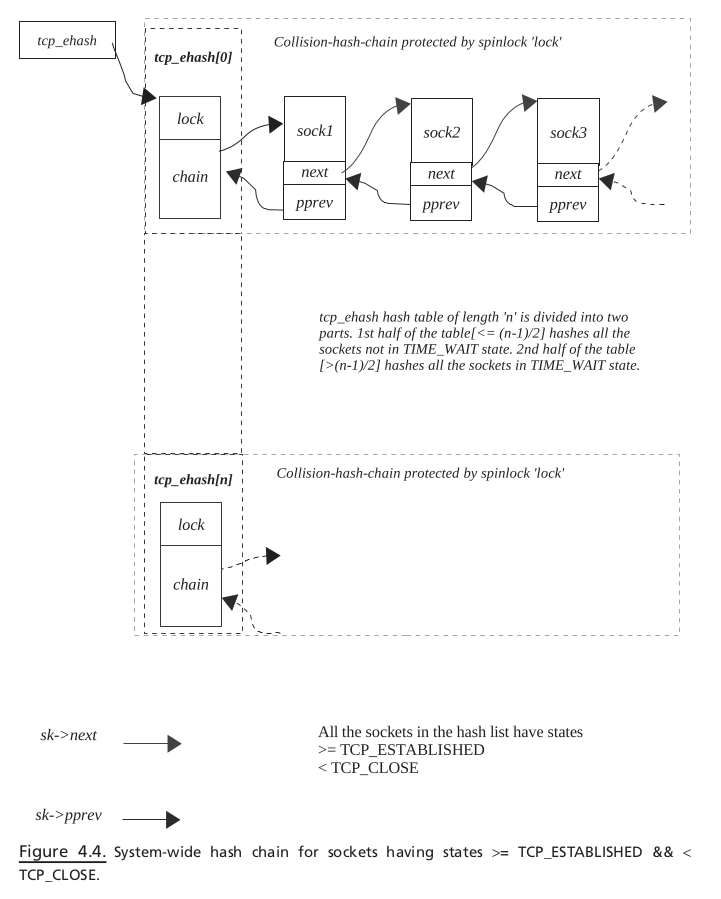
tcp_listening_hash#
Figure 4.5 illustrates snapshot of hash table hashing all the sockets in TCP_LISTEN STATE in the system. Listen hash table is discussed later in the chapter.

tcp_bhash#
Figure 4.6 illustrates snapshot of hash table hashing sockets based on the post to which they are bound bind hash table is discussed later in the chapter.
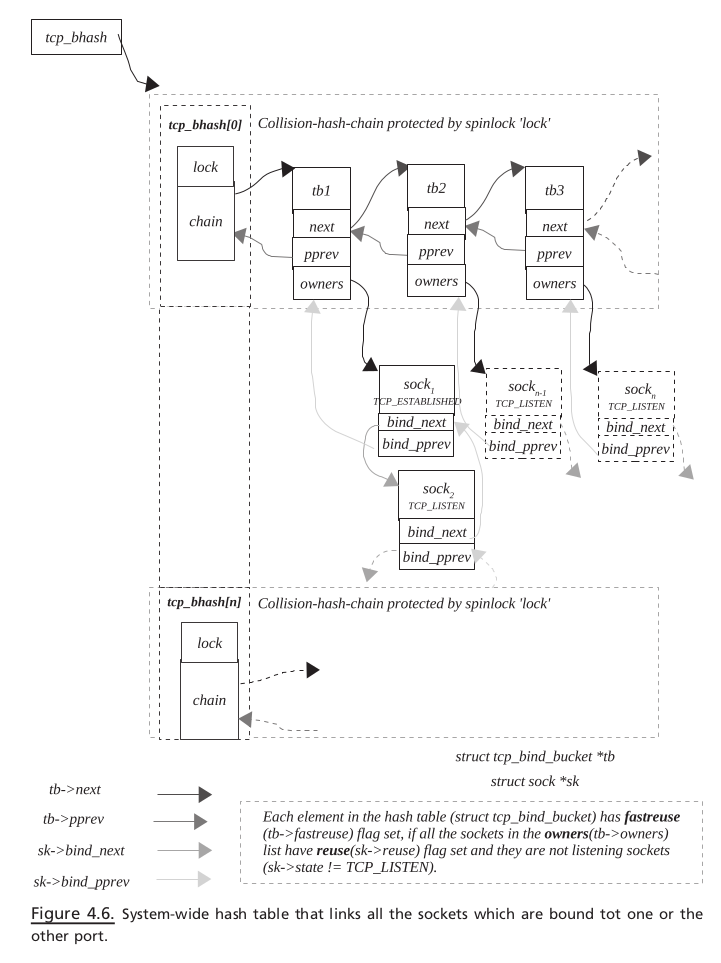
tcp_hashinfo#
This structure manages the tcp bind hash bucket. The members of tcp_hashinfo are as follows:
tcp _ bind _ hashbucket#
This describes the hash bucket and consists of two members: spinlock _ t lock : This is a lock to protect the collision hash chain chain . tcp _ bind _ bucket * chain : This is the element of the collision hash chain for the bind hash bucket.
tcp_bind_bucket#
This structure keeps information about the port number usage by sockets and the way the port number is being used. The information is useful enough to tell the new binding socket whether it can bind itself to a particular port number that is already in use. The data structure also keeps track of all the socket ’ s that are associated with this port number. unsigned short port : This is the port number associated with tcp_bind_bucket . Whenever a socket wants to bind itself to some port which is not in use, we allocate a new tcp_bind_bucket structure, assign the port number in question to port , and hash it in the tcp_bind_hashbucket . signed short fastreuse : This is the fl ag that indicates whether the port number that is already in use can be reused by a new socket. Whenever a new socket requests to allocate a port number to it, we check if the port number is already in use by some other socket. So, we check tcp_bind_hashbucket for the entry associated with a port number. Now if we have requested to bind the socket with the port number for which hash entry exists, we check for the fastreuse fl ag. If this fl ag is set, we are sure that we can bind the socket with the associated port number and add the socket to the owner ’ s list. In short, if the fastreuse fl ag is set, we have all the sockets in the owners list, which are as follows:
These sockets are bound to the same TCP port but on different network interfaces. We can have server applications listening on the same post but different IP address confi gured on different interfaces.
Or all the sockets have a reuse fl ag set and are not listening sockets, which means that for all the sockets in the owners list the following conditions should be met: sk → reuse & & sk → state != TCP_LISTEN
Or all the sockets are bound to the same port using same interface, but the recv_saddr for all the sockets is different
sys_bind ()#
sys_bind() is the function called inside the kernel with three arguments (Fig. 4.7 ).
fd : This is the socket file descriptor returned by socket call.
umyaddr : This is the socket address to which we want to bind the socket.
addrlen : This is the socket address length.
First, we do a lookup for the socket associated with the socket descriptor. This socket
descriptor is nothing but the file descriptor, and it links a socket with the VFS as
shown in Fig. 4.2 . So, we call sockfd_lookup() with the socket descriptor.

sockfd_lookup ()#
First the kernel needs to get the file structure from the current process ’ s file table.
We call fget() to do this.
inet_bind()#
tcp_v4_ get_port ()#
Arguments passed to this function is sock structure associated with the socket and the port number to which a socket needs to be bound. If the port number specifi ed is 0 in the socket address, we are asking the kernel to fi nd a free port number and allocate it to the socket. Here we need to select a free local port within the range specifi ed by sysctl_local_port_range[2] (1024 – 4999). This range can be changed by using sysctl. tcp_portalloc_lock is a global lock that serializes the port allocation. So, we need to hold the lock here before accessing any of these global variables associ- ated with port allocation. These are
LISTEN#
Here we need to tell the kernel that we are willing to accept the connections. At the same time we need to confi gure the socket as to how many socket connections the kernel should keep in the backlog queue before it starts rejecting the new con- nection request. The backlog queue for listening sockets may fi ll up for two reasons: • • In case the kernel is not able to process the request. In case the application has not invoked accept() systemcall. Once the backlog queue is full for the socket, the kernel rejects/drops the request. In the latter case, it sends a message to the client with error code ECONNREFUSED . listen() systemcall accepts two arguments:
Socket descriptor (ret urned by socket() systemcall).
Number and length of the backlog queue. Let ’ s see what happens inside tke kernel when we invoke listen() systemcall.
sys_listen()#
sys_listen() is called inside the kernel with the following arguments (Fig. 4.9 ):
fd : This is the socket fi le descriptor on which listen operates.
backlog : This is the length of the backlog queue to handle accepted connection requests for the listening socket.
First we try to get the sock entry corresponding to the socket descriptor, sockfd_lookup() . This function was explained earlier. Do some sanity check for length of
the backlog queue (should not be more than SOMAXCONN ).
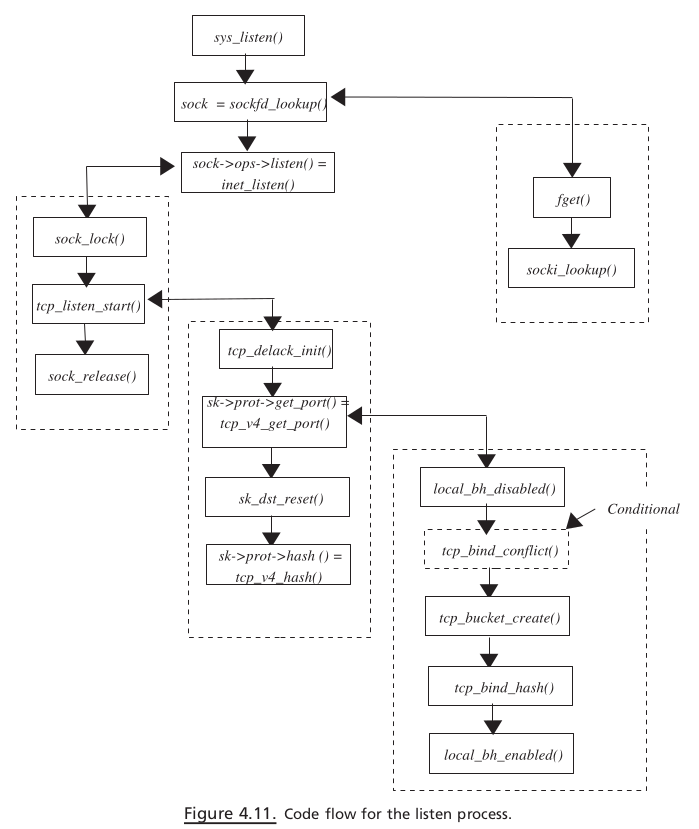
inet_listen()#
tcp_listen_start ()#
Listen Flow#
ACCEPT#
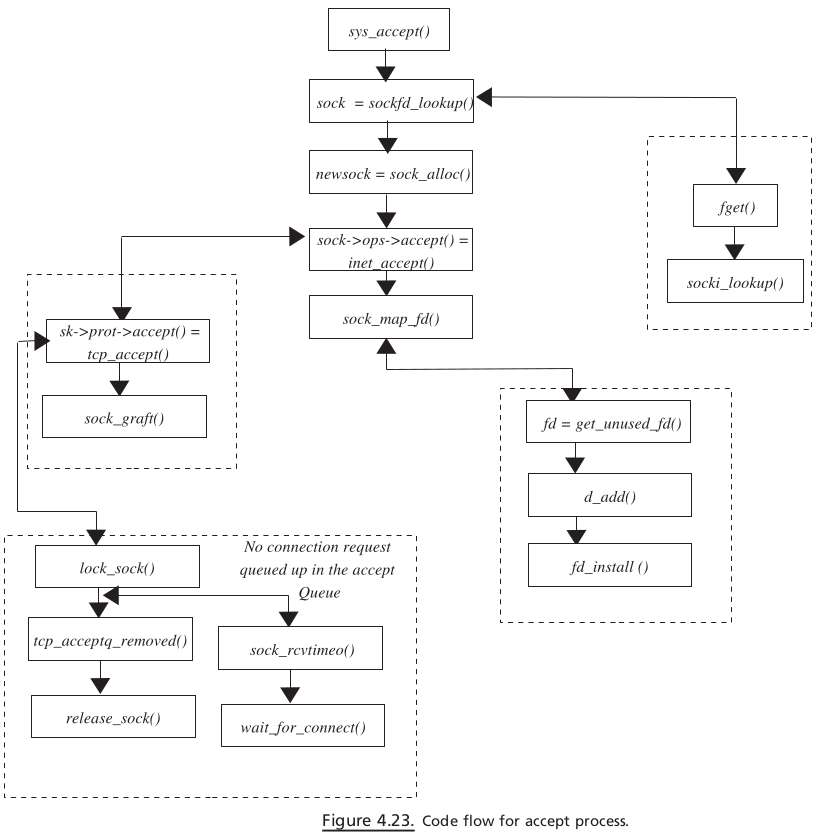
CLIENT SIDE SETUP#
Connect#
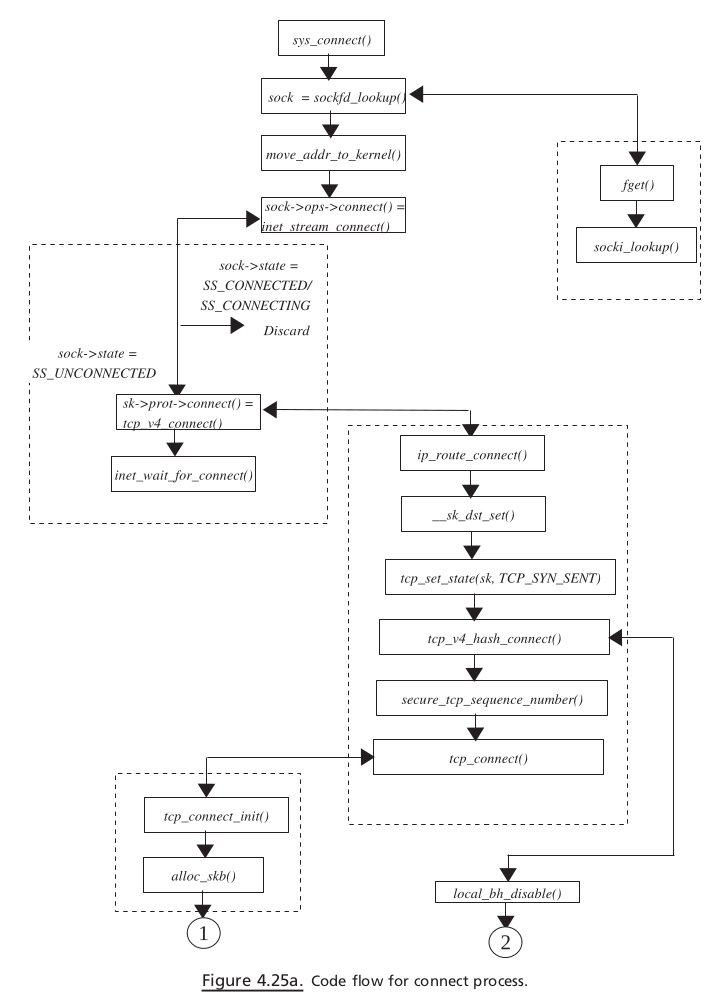
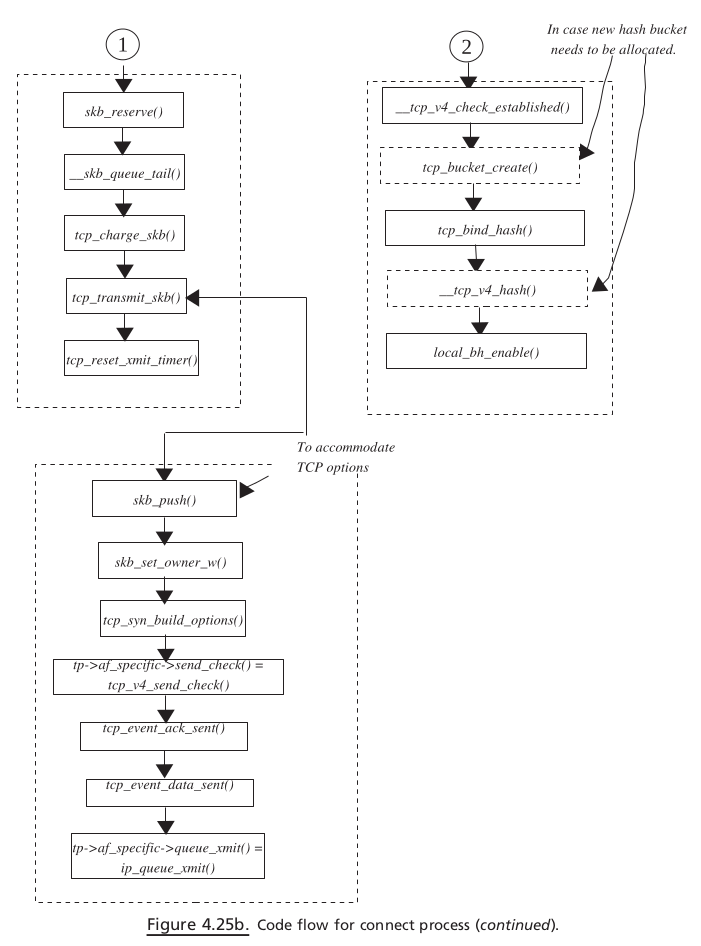
MOVEMENT OF sk_buff ACROSS PROTOCOL LAYERS#
PACKET TRAVERSING DOWN THE TCP / IP STACK#

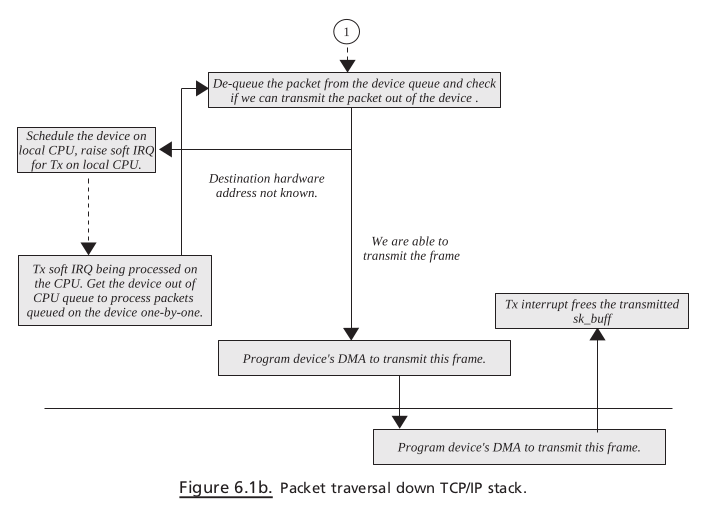


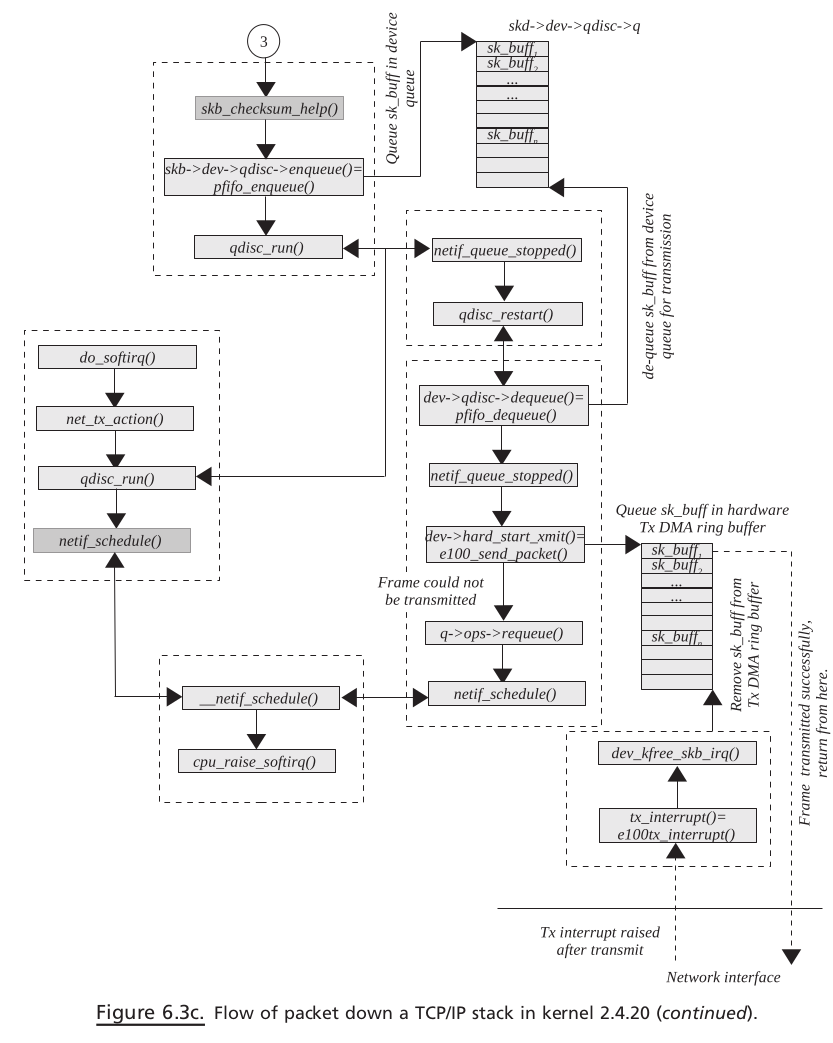
PACKET TRAVERSING UP THE TCP / IP STACK#
Kernel Path for TCP Packet Traversing Up the Stack#
Soft IRQ . SoftIRQ is processed in various places:
Just after we returned from the interrupt in interrupt context.
SoftIRQ daemon running per CPU.
Whenever softIRQ on the CPU is enabled.
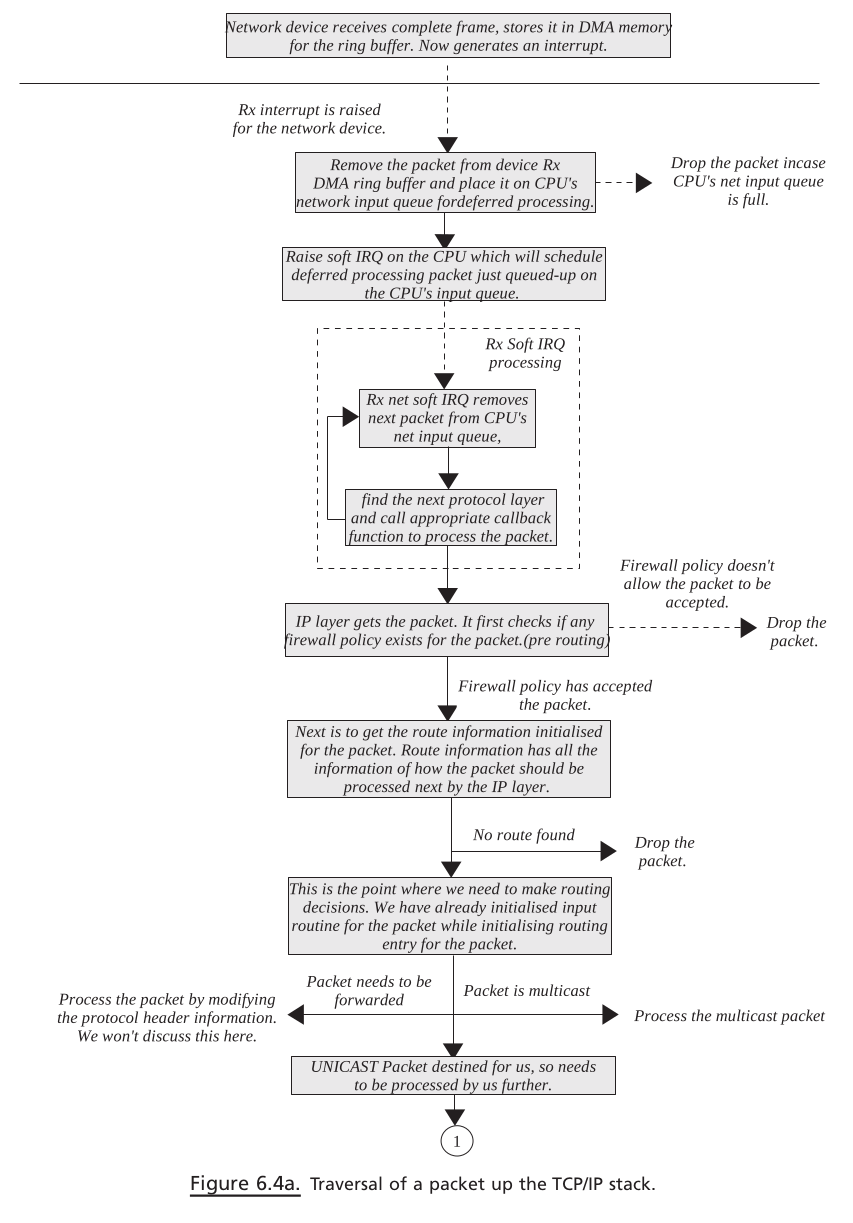

In the case where net Rx softIRQ is enabled, net_rx_action() is called just after we
return from the interrupt. This will start processing the packet received in the CPU ’ s
input queue. The packet is processed completely in softIRQ. Even though we are
in interrupt context, the interrupt for the controller is enabled so that NIC can
continue to receive packets and queue them on CPU ’ s input queue.



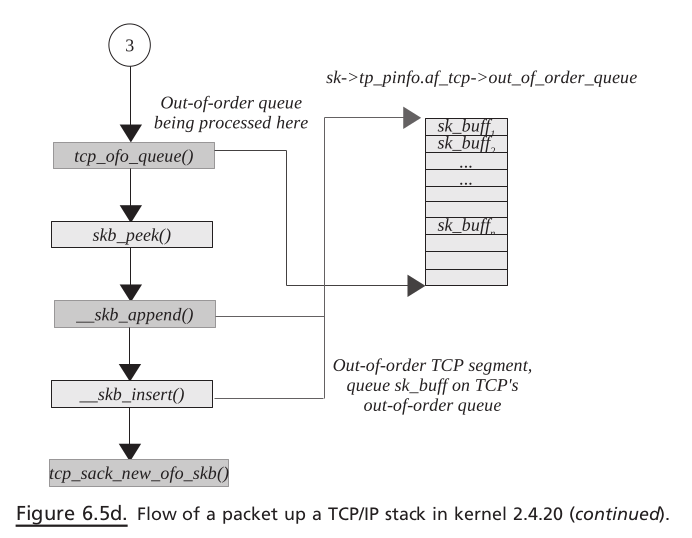
TCP SEND#
TCP RECEIVE#
TCP MEMORY MANAGEMENT#
TCP TIMERS#
Retransmit timer
Delayed ACK timer
Zero window probe timer (persistent timer)
Keep - alive timer
TIME_WAIT timer
SYN - ACK timer (timer for listening sockets)
TIMERS IN LINUX#

When Are Timer Routines Executed?#
Timer interrupt fires every 10 ms — that is, one tick. This interrupt raises soft Inter-
rupt to process timers by calling mark_bh() from do_timer(). To mark_bh() we pass
offset in the bh_task_vec[]. mark_bh() calls tasklet_hi_schedule() to schedule the
tasklet pointed to by bh_task_vec [TIMER_BH]. Here we first check if the tasklet
is not already scheduled. In the case where it is not already scheduled, we schedule
it by calling __tasklet_hi_schedule() (cs 10.5 ). This ensures that one tasklet is sched-
uled on only one CPU and that also the same tasklet cannot be scheduled on the
same CPU twice. This will schedule the timer tasklet on the CPU currently being
executed on. The tasklet is added to per CPU list tasklet_hi_vec[cpu].list and sub-
sequently HI_SOFTIRQ softirq is raised. On returning from timer interrupt,
do_softirq() is executed, which will check for softirq ’ s to be processed. Here, HI_
SOFTIRQ is processed, which will also process tasklet_hi_vec list for that CPU. This
list includes TIMER_BH tasklet, which gets executed as timer_bh(). run_timer_list()
is called from timer_bh() to execute all the timers from the global list which have
expired.
TCP RETRANSMIT TIMER#
When Do We Set Retransmit Timer?#
When Do We Reset or Cancel Retransmit Timers?#
TCP CORE PROCESSING#
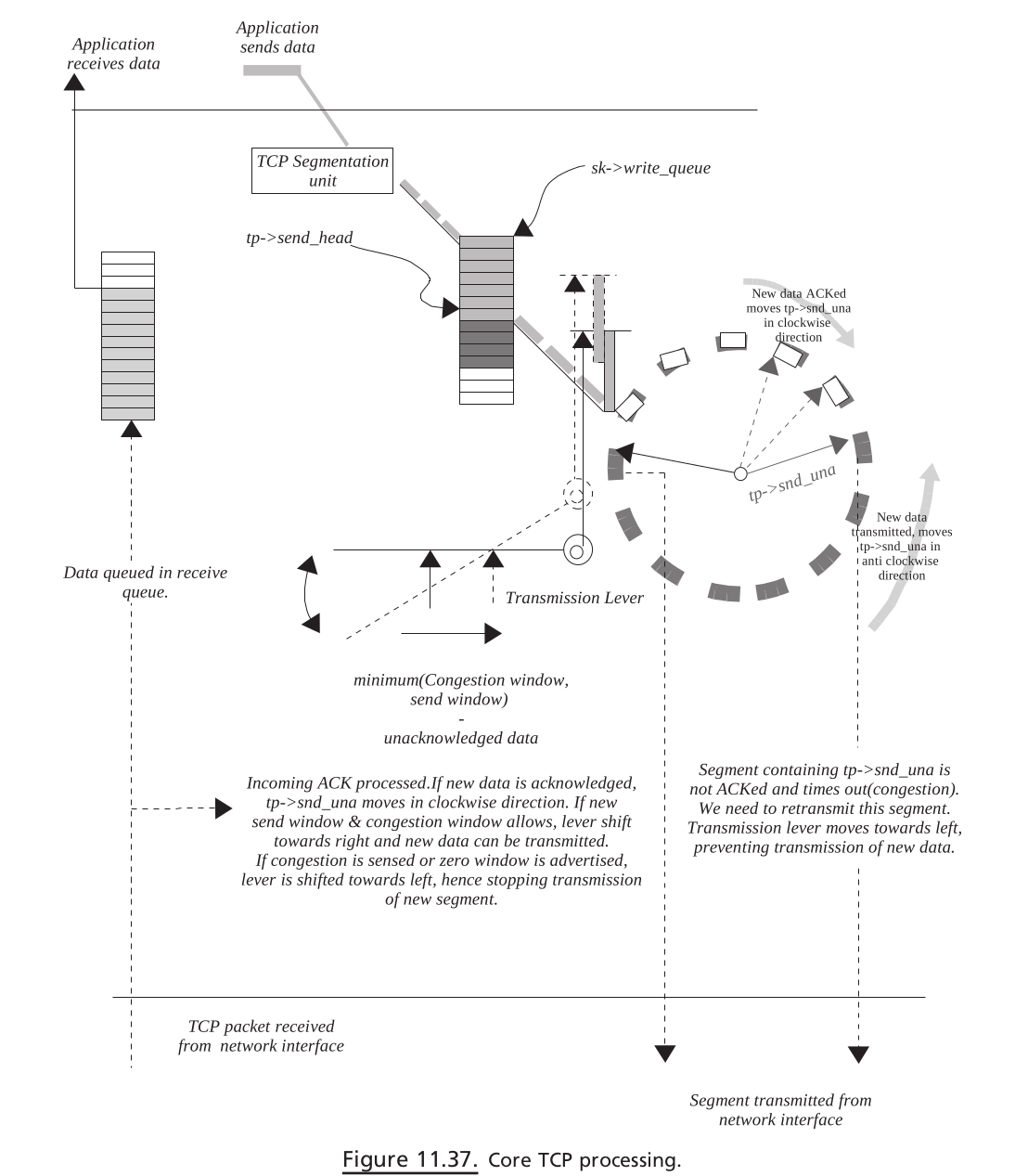
Figure 11.37. Core TCP processing.
TCP STATE PROCESSING#
NET SOFT IRQ#
HOW ARE SOFT IRQS PROCESSED, AND WHEN?#
do_softirq() is called when we:
Return from interrupt in do_IRQ() (cs 17.10 ). We have just returned from an interrupt routine, and there is a chance that some softIRQ is raised as most of the interrupt work is done in bottom half now implemented as softIRQ. That is the reason why we check here. There may be a chance that softIRQ
on the local CPU is disabled because of any valid reason. In this case, any softIRQ will not be processed even if raised.
Enable local bottom halves locally by calling
local_bh_enable().
